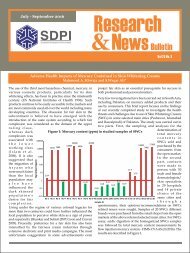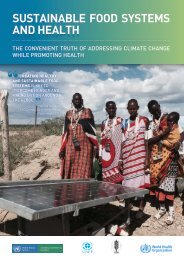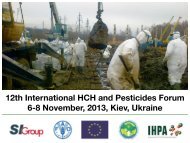Women and Chemicals
WomenAndChemicals_PublicationIWD2016
WomenAndChemicals_PublicationIWD2016
Create successful ePaper yourself
Turn your PDF publications into a flip-book with our unique Google optimized e-Paper software.
Summary<br />
mented by governments. UNEP is developing a toolkit on protecting<br />
vulnerable groups from POPs <strong>and</strong> heavy metals; the publication<br />
is still in process.<br />
This report looks at health research, exposure data, <strong>and</strong><br />
best practice policies to prevent exposure <strong>and</strong> health impacts.<br />
However, protection of women from hazardous chemicals is<br />
not enough. <strong>Women</strong> also have to be empowered as agents of<br />
change. With better information on the specific links between<br />
their health <strong>and</strong> hazardous chemicals, women can play a significant<br />
role as active supporters of the “2020 goal” of implementing<br />
the sound management of chemicals throughout<br />
their life cycle. Well-informed individuals need to cooperate on<br />
legislative development, enforcement, capacity building, production<br />
of safer alternatives, information <strong>and</strong> awareness raising,<br />
to ensure that chemicals are produced <strong>and</strong> used in ways that<br />
minimize significant adverse impacts on human health <strong>and</strong> the<br />
environment worldwide.<br />
There is little comprehensive information available on the<br />
risks of hazardous chemicals to women’s health; this study intends<br />
to make the first step to fill this gap. It shows that numerous<br />
scientific studies link exposure to hazardous chemicals with<br />
development of certain diseases <strong>and</strong> disorders including breast<br />
cancer, obesity, <strong>and</strong> infertility, which are most commonly experienced<br />
by women. The chapter “Where are women exposed to<br />
chemicals?” describes how women are exposed to hazardous<br />
chemicals at home, at work, in the environment <strong>and</strong> during different<br />
life stages including during pregnancy. The following<br />
chapters give a brief summary about on-going activities of international<br />
organisations, NGOs, business <strong>and</strong> governments on the<br />
specific issue of women <strong>and</strong> chemicals. These are rather limited,<br />
as an overview of current literature <strong>and</strong> websites shows, <strong>and</strong> are<br />
often found as part of studies on other topics such as for example<br />
occupational health or specific chemicals. In the current discussions<br />
on Endocrine Disrupting <strong>Chemicals</strong> (EDCs), pesticides<br />
<strong>and</strong> mercury some data is available on the effect that these hazardous<br />
chemical substances have particularly on women. However,<br />
there is still a great need for more in-depth information <strong>and</strong><br />
work to be done on the socio-economic impacts of chemicals<br />
on women. Hence it is necessary to better underst<strong>and</strong> these implications<br />
for the design of projects <strong>and</strong> programmes that actually<br />
help affected women in the long term.<br />
This study is only the first step, as more information needs to be<br />
explored <strong>and</strong> compiled by:<br />
• searching for best practice projects in implementation, capacity<br />
building <strong>and</strong> awareness raising <strong>and</strong> their indicators for success;<br />
• collecting more gender <strong>and</strong> sex disaggregated data on issues<br />
like exposure scenarios, impacts of hazardous chemicals on<br />
women’s health, activities to reduce exposures for women;<br />
• developing indicators for better measurement of hazardous<br />
chemicals’ impacts on women, especially through more research<br />
on sources <strong>and</strong> pathways of exposure.<br />
Yet with the information at h<strong>and</strong>, immediate concrete action can<br />
be taken by:<br />
• issuing a h<strong>and</strong>book on women <strong>and</strong> chemicals, with articles<br />
from experts presenting the latest in-depth information <strong>and</strong><br />
research on women <strong>and</strong> chemicals;<br />
• supporting the issue of women <strong>and</strong> chemicals as a priority issue<br />
under the Strategic Approach to International <strong>Chemicals</strong><br />
Management (SAICM);<br />
• integrating a gender focus into existing funding schemes;<br />
• allocating <strong>and</strong> providing funding for projects on women <strong>and</strong><br />
chemicals.<br />
To support the goal of empowering women <strong>and</strong> protecting<br />
them from hazardous chemicals, the following immediate action<br />
points are recommended:<br />
• make the most vulnerable group, in this case children <strong>and</strong><br />
pregnant women, the norm (<strong>and</strong> not the exception) for developing<br />
threshold limits, where there are safe threshold limits;<br />
• support m<strong>and</strong>atory labelling of all chemicals in products to ensure<br />
the right to know;<br />
• strengthen women’s rights, in particular their participatory<br />
rights, in all aspects of decision making, chemical production,<br />
use <strong>and</strong> disposal;<br />
• clean up all chemical <strong>and</strong> heavy metal polluted ‘hot spots’ to<br />
protect the population living nearby <strong>and</strong> avoid further<br />
contamination;<br />
• implement the precautionary principle for chemicals which are<br />
harmful or suspected to be harmful to human health <strong>and</strong> environment,<br />
by regulatory measures.<br />
This first scoping overview on “<strong>Women</strong> <strong>and</strong> <strong>Chemicals</strong>” addresses<br />
policy makers, national competent authorities, international<br />
organisations, science, business <strong>and</strong> civil society. It will provide<br />
initial thoughts on the topic of women <strong>and</strong> chemicals <strong>and</strong> it aims<br />
to motivate further thought <strong>and</strong> research to design activities,<br />
which aim to empower women <strong>and</strong> to protect them from hazardous<br />
chemicals. Further work will need to be done to complete<br />
the gender picture <strong>and</strong> address the impacts of hazardous chemicals<br />
on men <strong>and</strong> boys.<br />
7







